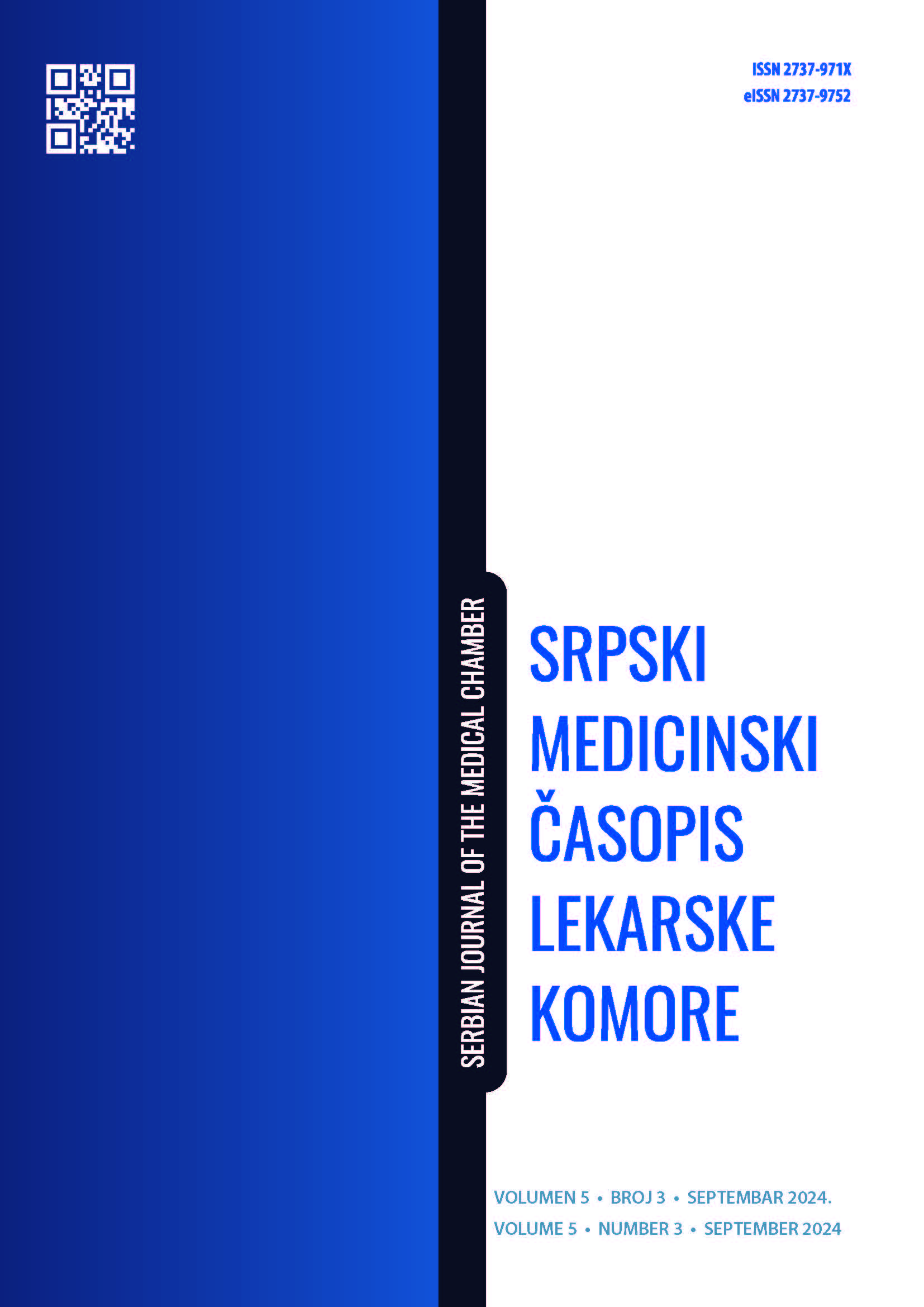DISEASE PROGRESSION IN PATIENTS WITH LOW-RISK PRIMARY MYELOFIBROSIS – CASE REPORT
Abstract
Introduction: The median survival (OS) of patients with low-risk PMF is over 15 years, but according to the "MOST" prospective study, disease progression occurs in almost 60% of these patients.
Aim: to present the disease course and treatment outcome of patients with low-risk PMF.
Case report: All patients were diagnosed with PMF, low-risk IPSS, and normal initial cytogenetics.
Case 1: A 61-year-old male patient was admitted in May 2016 with Tr 772x109/L, LDH 566 U/L, no splenomegaly, JAK2V617F+. He was initially treated with hydroxyurea (HU) from 2016 to 2020. In 2021, he was introduced to ruxolitinib due to the development of splenomegaly and leukocytosis, with disease progression 18 months later (spleen 26 cm, Plt 20x109/L, 10% blasts in the marrow, complex karyotype: -5, del 7q, mar+). Azacitidine was introduced, but death occurred due to sepsis in October 2022. OS is 66 months.
Case 2: A 47-year-old female patient was admitted in July 2011 with Tr 899x109/L, LDH 899 U/L, spleen 15x7 cm, JAk2V617F+, and ASXL+. She was initially treated with HU and has been treated with ruxolitinib since October 2013 due to the progression of splenomegaly (spleen 19.3 cm, LDH 1881 U/L), with subsequent normalization of spleen size, number of Tr, and LDH. The patient is in remission. OS is 126 months.
Case 3: A 64-year-old male patient was admitted in May 2012 with Tr 1457x109/L, LDH 631 U/L, borderline splenomegaly, JAk2V617F-, MPL+, SRSF2+, U2AF1+, ASXL1+. He was initially treated with HU (May 2012) and since April 2019 with danazol due to the emergence of transfusion dependence. Due to heart failure, death occurred in February 2020. OS is 96 months.
Conclusion: Some patients with low-risk PMF have disease progression, and future studies will show whether early NGS analysis of non-driver mutations and early initiation of therapy contribute to changing the course of the disease.
References
England JT, McNamara CJ, Kennedy JA, Capo-Chichi JM, Huang J, Arruda A, et al. Clinical and molecular correlates of JAK-inhibitor therapy failure in myelofibrosis: long-term data from a molecularly annotated cohort. Leukemia. 2022 Jun;36(6):1689-92. doi: 10.1038/s41375-022-01544-x.
Li Y, Zhu S, Liu W, Ming J, Wang X, Hu X. Ruxolitinib-based combinations in the treatment of myelofibrosis: worth looking forward to. Ann Hematol. 2020 Jun;99(6):1161-76. doi: 10.1007/s00277-020-04028-z.
Tefferi A. Primary myelofibrosis: 2023 update on diagnosis, risk-stratification, and management. Am J Hematology. 2023 May;98(5):801-21. doi: 10.1002/ajh.26857.
Kvasnicka HM, Thiele J. Prodromal myeloproliferative neoplasms: the 2008 WHO classification. Am J Hematol. 2010 Jan;85(1):62-9. doi: 10.1002/ajh.21543.
Tefferi A, Nicolosi M, Mudireddy M, Lasho TL, Gangat N, Begna KH, et al. Revised cytogenetic risk stratification in primary myelofibrosis: analysis based on 1002 informative patients. Leukemia. 2018 May;32(5):1189-99. doi: 10.1038/s41375-018-0018-z.
Tefferi A, Pardanani A. Myeloproliferative neoplasms: a contemporary review. JAMA Oncol. 2015 Apr;1(1):97-105. doi: 10.1001/jamaoncol.2015.89.
Cervantes F, Dupriez B, Pereira A, Passamonti F, Reilly JT, Morra E, et al. New prognostic scoring system for primary myelofibrosis based on a study of the International Working Group for Myelofibrosis Research and Treatment. Blood. 2009 Mar 26;113(13):2895-901. doi: 10.1182/blood-2008-07-170449.
Passamonti F, Cervantes F, Vannucchi AM, Morra E, Rumi E, Pereira A, et al. A dynamic prognostic model to predict survival in primary myelofibrosis: a study by the IWG-MRT (International Working Group for Myeloproliferative Neoplasms Research and Treatment). Blood. 2010 Mar 4;115(9):1703-8. doi: 10.1182/blood-2009-09-245837.
Cervantes F. How I treat myelofibrosis. Blood 2014 Oct 23;124(17):2635-42. doi: 10.1182/blood-2014-07-575373.
Bose P. Management of patients with early myelofibrosis: a discussion of best practices. Curr Hematol Malig Rep. 2024 Jun;19(3):111-9. doi: 10.1007/s11899-024-00729-8.
Gerds AT, Lyons RM, Colucci P, Kalafut P, Paranagama D, Verstovsek S. Disease and clinical characteristics of patients with a clinical diagnosis of myelofibrosis enrolled in the MOST study. Clin Lymphoma Myeloma Leuk. 2022 Jul;22(7): e532-40. doi: 10.1016/j.clml.2022.02.001.
Al-Ali HK, Griesshammer M, Foltz L, Palumbo GA, Martino B, Palandri F, et al. Primary analysis of JUMP, a phase 3b, expanded-access study evaluating the safety and efficacy of ruxolitinib in patients with myelofibrosis, including those with low platelet counts. Br J Haematol. 2020 Jun;189(5):888-903. doi: 10.1111/bjh.16462.
Mead AJ, Milojkovic D, Knapper S, Garg M, Chacko J, Farquharson M, et al. Response to ruxolitinib in patients with intermediate-1-, intermediate-2-, and high-risk myelofibrosis: results of the UK ROBUST Trial. Br J Haematol. 2015 Jul;170(1):29-39. doi: 10.1111/bjh.13379.
Sørensen AL, Mikkelsen SU, Knudsen TA, Bjørn ME, Andersen CL, Bjerrum OW, et al. Ruxolitinib and interferon-α2 combination therapy for patients with polycythemia vera or myelofibrosis: a phase II study. Haematologica. 2020 Sep 1;105(9):2262-72. doi: 10.3324/haematol.2019.235648.
Shah S, Talati C, Al Ali N, Padron E, Sallman DA, Sweet KL, et al. Investigating patient characteristics and outcomes of myelofibrosis patients with hyperleukocytosis. Blood. 2018 Nov 29;132(Suppl 1):3041. doi: 10.1182/blood-2018-99-117834.
Yan X, Xu Z, Zhang P, Sun Q, Jia Y, Qin T, et al. Non-driver mutations landscape in different stages of primary myelofibrosis determined ASXL1 mutations play a critical role in disease progression. Blood Cancer J. 2023 Apr 20;13(1):56. doi: 10.1038/s41408-023-00829-3.
Komrokji RS, Grunwald MR, Braunstein E, Hamer-Maansson JE, Kalafut P, Mascarenhas J. Disease progression and leukemic transformation in patients with lower-risk myelofibrosis (MF): an analysis from MOST. Blood. 2022 Nov 15;140(Suppl 1):6832-4. doi: 10.1182/blood-2022-159181.

